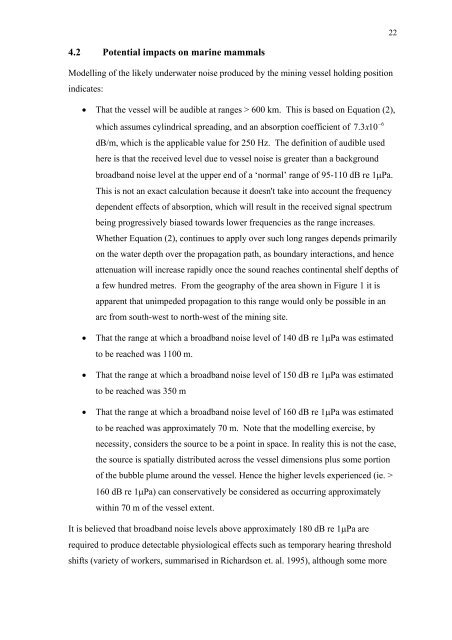Appendices 5-13 - Nautilus Cares - Nautilus Minerals
Appendices 5-13 - Nautilus Cares - Nautilus Minerals
Appendices 5-13 - Nautilus Cares - Nautilus Minerals
You also want an ePaper? Increase the reach of your titles
YUMPU automatically turns print PDFs into web optimized ePapers that Google loves.
4.2! Potential impacts on marine mammals<br />
Modelling of the likely underwater noise produced by the mining vessel holding position<br />
indicates:<br />
* That the vessel will be audible at ranges > 600 km. This is based on Equation (2),<br />
which assumes cylindrical spreading, and an absorption coefficient of<br />
7.<br />
3x<br />
10<br />
dB/m, which is the applicable value for 250 Hz. The definition of audible used<br />
here is that the received level due to vessel noise is greater than a background<br />
broadband noise level at the upper end of a ‘normal’ range of 95-110 dB re 1"Pa.<br />
This is not an exact calculation because it doesn't take into account the frequency<br />
dependent effects of absorption, which will result in the received signal spectrum<br />
being progressively biased towards lower frequencies as the range increases.<br />
Whether Equation (2), continues to apply over such long ranges depends primarily<br />
on the water depth over the propagation path, as boundary interactions, and hence<br />
attenuation will increase rapidly once the sound reaches continental shelf depths of<br />
a few hundred metres. From the geography of the area shown in Figure 1 it is<br />
apparent that unimpeded propagation to this range would only be possible in an<br />
arc from south-west to north-west of the mining site.<br />
* That the range at which a broadband noise level of 140 dB re 1"Pa was estimated<br />
to be reached was 1100 m.<br />
* That the range at which a broadband noise level of 150 dB re 1"Pa was estimated<br />
to be reached was 350 m<br />
* That the range at which a broadband noise level of 160 dB re 1"Pa was estimated<br />
to be reached was approximately 70 m. Note that the modelling exercise, by<br />
necessity, considers the source to be a point in space. In reality this is not the case,<br />
the source is spatially distributed across the vessel dimensions plus some portion<br />
of the bubble plume around the vessel. Hence the higher levels experienced (ie. ><br />
160 dB re 1"Pa) can conservatively be considered as occurring approximately<br />
within 70 m of the vessel extent.<br />
It is believed that broadband noise levels above approximately 180 dB re 1"Pa are<br />
required to produce detectable physiological effects such as temporary hearing threshold<br />
shifts (variety of workers, summarised in Richardson et. al. 1995), although some more<br />
-6<br />
22


